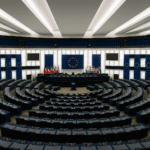The Cloud We Don’t Control
Europe’s cloud infrastructure is not primarily based in Europe. As of 2024, Amazon Web Services (AWS) controls approximately 41% of the European cloud market, followed by Microsoft Azure at 21% and Google Cloud at 11%, according to Synergy Research Group. Collectively, these American providers manage more than 70% of European data, including critical sectors such as healthcare, financial services, public administration, and national defence. This is not merely a technological dependency. It is a structural asymmetry with geopolitical implications.
“If you don’t own your cloud, you don’t own your country.”
The U.S. CLOUD Act (2018) requires American firms to provide access to data held globally, regardless of local jurisdiction. Meanwhile, China’s National Intelligence Law (2017) requires all domestic companies to cooperate with state security services. Despite having some of the world’s strongest data protection laws, Europe has no equivalent enforcement power over the infrastructure it relies on.
A clear case of contradiction emerged when France’s Health Data Hub was launched on Microsoft Azure. Despite branding the system a “sovereign cloud,” it operated under a platform subject to U.S. law — an arrangement criticised by France’s data protection authority (CNIL), which warned that health data from millions of French citizens could be subject to extraterritorial access.
GAIA-X was Europe’s coordinated response. Yet by 2023, major contributors like Scaleway had publicly withdrawn, calling the initiative a “dead end.” In a resignation letter, Scaleway’s CEO stated: “The project’s complexity and lack of direction have made it practically unworkable.” The platform, once envisioned as a federated cloud ecosystem with shared sovereignty principles, remains conceptual primarily.
A Failure of Vision and Investment
Europe’s cloud infrastructure shortcomings are not due to a talent shortage. They stem from underinvestment, institutional inertia, and policy inconsistency. Between 2010 and 2022, EU venture capital averaged less than 25% of U.S. levels. In strategic sectors like AI, cloud services, and microelectronics, the disparity is even more pronounced.
“Europe cannot rely on exporting regulation and importing innovation.”
This capital gap is compounded by fragmentation. While Silicon Valley operates as a unified ecosystem, Europe’s innovation landscape remains fractured. For example, while Estonia’s e-residency program has pioneered digital government architecture, it remains an isolated success rather than a model replicated across the EU. Germany’s Smart Country initiative and France’s Cloud de Confiance have suffered from limited adoption and unclear scaling paths.
Non-EU entities acquired more than 120 European-founded deep-tech firms between 2015 and 2022. One example is DeepMind, initially founded in London, which was acquired by Google in 2014 and is now a key part of Alphabet’s AI dominance. Europe is becoming an intellectual export zone: it seeds innovation but imports dependency.
Even EU-led initiatives, such as the Digital Decade strategy, have been hampered by vague timelines and modest funding. While European officials debated governance for GAIA-X, U.S. and Chinese firms captured global markets in large language models, AI toolchains, and sovereign-grade compute infrastructure.
Digital Sovereignty Is Civilisational Sovereignty
Control over cloud infrastructure equates to control over knowledge, coordination, and command. It determines who owns the architecture behind public services, machine learning, research, and digital identity.
“Europe’s autonomy is only as strong as its architecture.”
Europe’s reliance on foreign platforms undermines not only its legal frameworks but also its cultural and political autonomy. U.S.-based providers fall under laws that directly conflict with European norms, such as GDPR. The result is an unresolved jurisdictional overlap that leaves citizens’ rights subject to interpretation by foreign authorities.
In early 2022, Microsoft and Amazon provided critical infrastructure to Ukraine during Russia’s invasion. While commendable, the episode laid bare the EU’s inability to act independently in times of crisis. No sovereign capability existed to replicate such action at scale.
A telling case occurred when Germany’s Federal Employment Agency moved its unemployment data to AWS. Local options were deemed insufficient. Sovereignty was traded for reliability. This trade-off is not isolated. Denmark’s 2021 decision to outsource its national education platform to Google Workspace, despite public opposition and privacy concerns, is another example of prioritising convenience over control.

The Missing Pillars — Education, Culture, and Courage
Europe’s cloud infrastructure issue isn’t a lack of engineers — it’s a lack of ecosystems. Risk-averse funding models, conservative procurement rules, and outdated education systems create environments hostile to disruption.
“The EU doesn’t need another ethics board. It needs a server farm.”
According to the European Court of Auditors, only 14% of EU digital contracts go to startups. Most public-sector tech budgets default to large vendors. Meanwhile, curricula across the continent emphasise theory over deployment, and failure remains culturally stigmatised.
This is why European innovators leave. For instance, TransferWise (now Wise), a fintech success story, moved its operational headquarters to the UK despite Estonian origins. Similarly, Skype — another Estonian-born tech firm — ended up under Microsoft’s control.
“If Europe wants digital sovereignty, it must first want digital greatness.”
The Path Forward — From Users to Makers
Europe must act as though its future depends on this — because it does. Cloud infrastructure is not merely an economic domain. It is a battlefield of sovereignty, strategy, and civilisational continuity.
What Europe Must Do:
- Create sovereign cloud alliances across member states with mandatory data localisation
- Establish EU-funded supercomputing hubs for research and AI innovation
- Reform procurement to prioritise EU-built platforms and startup-friendly frameworks
- Incentivise the repatriation of founders through tax credits and relocation support
- Embed digital sovereignty into constitutional principles at the EU and national levels
“Europe must now lead the way on digital – or it will have to follow the way of others, who are setting these standards for us.” — Ursula von der Leyen, President of the European Commission, 2020
As Heidegger warned, technology without thought can transform humans into resources. Europe’s path forward must reflect more than digital capabilities — it must reflect its values. Infrastructure is destiny.
Defend Europe’s Future
Europe’s digital future cannot be outsourced. If this article helped you understand what’s at stake, share it now — wake others up to the hidden threats of outsourcing our innovation and importing dependence. Knowledge is the first line of defence.
To directly support real-world operations protecting Europe’s sovereignty — from digital defence to drone support on the physical front — consider donating today. Your contribution reaches the ground where it’s needed most.
👉 Share this article. Spread the signal. Support the frontline.







